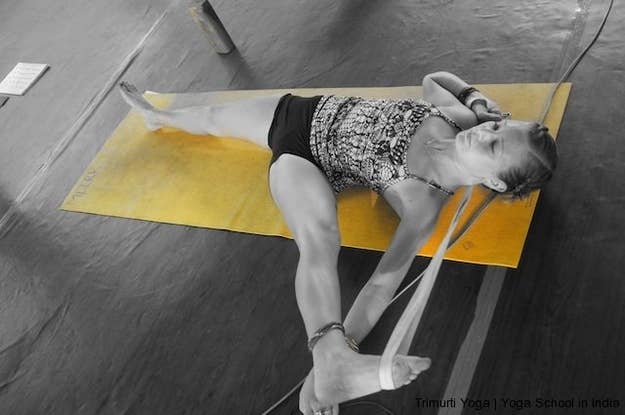
The program of our Yoga TTC is based on Yoga Alliance Standards and includes:
Techniques Training/Practice – Includes asanas, pranayamas, kriyas, chanting, mantras, meditation and other traditional yoga techniques. These hours are a mix between (1) analytical training in how to teach and practice the techniques, and (2) guided practice of the techniques themselves;
Teaching Methodology – Includes principles of demonstration, observation, assisting/correcting, instruction, teaching styles, qualities of a teacher, the student's process of learning, and business aspects of teaching yoga.
Anatomy & Physiology – Includes both human physical anatomy and physiology (bodily systems, organs, etc.) and energy anatomy and physiology (chakras, nadis, etc.). Includes both the study of the subject and application of its principles to yoga practice (benefits, contraindications, healthy movement patterns, etc).
Yoga Philosophy/Lifestyle and Ethics for Yoga Teachers – Includes the study of yoga philosophies, yoga lifestyle, and ethics for yoga teachers.
Practicum – Includes practice teaching, receiving feedback, observing others teaching and hearing/giving feedback. Also includes assisting students while others are teaching
We enriched Yoga Alliance program with special activities – additional group workshops such as improvisation dance & theater workshops which will help you to understand your body and Inner-Self, various breathing and meditation techniques including dynamic meditations, movement meditations, silent walk to the mountains and more…
OUR PROGRAM WITH DETAILS:
Techniques Training & Practice
Kriyas– theory and practice; benefits and contraindications, techniques and practical tips: Jala Neti, Sutra Neti, Shankhaprakshalana (Langhoo Shankhaprakshalana), Vaman Dauti (Kunjal Kriya), Kapalbhati, Trataka
Bandhas – lecture & practice: Jalandhara Bandha, Moola Bandha, Uddiyana Bandha, Maha Bandha
Pranayama – lecture & everyday practical training: Prana & Pranic Body, abdominal/diaphragmatic breathing, thoracic breathing, yogic breathing, alternate nostril breathing, Sheetali Pranayama, Sheetkari Pranayama, Bhramari Pranayama, Ujjayi Pranayama, Bhastrika Pranayama, Kapalbhati
Mudras – meaning and practice: Jnana Mudra, Chin Mudra, Yoni Mudra, Bhairava Mudra, Hridaya Mudra
Meditation techniques: silent sitting (Vipasana), dynamic meditations, dance meditations, kundalini meditation, chakra breathing, silent walking in nature, silent day (individual), art meditation(meditation through art)
Mantras and chanting
ASANAS PRACTICE including:
Warm-up exercises & Sun Salutation in few variations
Asanas practice presenting various styles (guided and analytical training every day):
Ashtanga Primary Series
Vinyasa Flow: general sessions & thematic sessions: "Happy Hips", "Heart opening", "Chakra journey", "Re-balancing Flow", "Dancing Yogis", etc.
Smooth restorative yoga
Iyengar yoga with props
Yoga for health
Yoga for stress management
12 basic Sivananda Asanas
Going "in" and "out" of the posture
"key" of the postures
Modifications for beginners and students with injuries (multi-level modifications)
Sequencing – various schools of Yoga
Special classes including Pre-natal Yoga, "Golden Age" Yoga, Kids Yoga, Yoga for Diabetes
Guided asanas practice & analytical training focused on following groups of asanas:
Standing asanas
Forward bends
Back bends
Twists
Balances
Inversions
Hip openers
Finishing sequence & relaxing asanas
student's self-practice under teacher's control (individual tips)
Vinyasa (tunning asanas with breathing) – guided and analytical practice
Practical exams of asanas
Teaching Metodology
Art of teaching: teacher's qualities , intentions & attitude, teaching styles, observation (general & particular, giving instructions, feedback, sequencing, class management & class routine, principles of demonstration – theory and practice ("mirror" versus "real", how to demonstrate, how not to demonstrate, practice in groups + feedback)
Tasks of Yoga Teacher
Anatomy of alignment – theory and practice
Safety First! – how to teach and practice Yoga without injuries
Correction techniques
Modes of adjustment – verbal, hands-on, props, partners
"Art of touch" – physical adjustment
Practice in pairs on concrete asanas
Yoga in the marketplace:
Setting up yoga business
Start & development – practical tips
Marketing strategies
Public Relations / Advertising
Business & ethics
From beginner to advanced practitioner – yoga learning process and its phases
Practical workshop:
Communication and building conscious interactions
Written assignment on chosen topics connected to teaching methodology

Anatomy & Physiology
General movement and body terminology
Systems of the human body – their meaning and functions
Nervous, Skeletal and Muscular systems and their co-relations in context of yoga practice
Breath deeply! – respiratory system in the context of hatha yoga
The way we move – the key muscles of hatha yoga – analyses of muscular work in asana practice (theory & practice)
Body's main limitations: compression – tension – proportion – orientation and their meaning in asana practice
Yoga and health – benefits and contraindications of asanas; basic elements of yoga therapy
Energy channels & Chakra theory
Written assignment on muscles in context of yoga practice + written & practical tests
Yoga Philosophy, Lifestyle and Ethics for Yoga Teachers
Essence of Yoga – history, definitions, modes, contemporary meaning:
Historical and cultural background of Yoga
Definition of yoga and its interpretations
4 paths of yoga (Bhakti, Jnana, Karma, Raja)
5 pillars of yoga
3 gunas
Kleshas
Karma & reincarnation
Vedas, Upanishads, Bhagavad Gita – study on selected texts
OM/ AUM and its meaning
Patanjali Yoga Sutras and their interpretations (selection); 8 limbs of yoga and their meaning in the contemporary World
Ethics for yoga teachers:
values and meaning of being Yogi
the place for Yogi in today's World
yogic daily routine: principles of diet, meaning of practice and essence of lifestyle
Guided group discussion about basic philosophical issues related to yoga:
The Self and The Ego
The Consciousness
Self Awareness
The Responsibility of being a Yoga Teacher
Written assignment on selected philosophical topics & finishing test
Practicum
Practice of teaching under teacher's control:
In pairs
In small groups
In big group
Open free class for people under teacher's control
Practical exam of teaching
Feedback – receiving & giving
DAILY SCHEDULE
6.30 – 7.30 – morning pranayama, meditation & kriya yoga
7.30 – 9.00 – morning asana practice
9.00 – breakfast
10.00 – 11.15 – anatomy & physiology / philosophy
11.30 – 13.00 – Art of teaching (workshop)
1.00 pm – 3 pm – lunch break
3.00 pm – 4.00 – philosophy/anatomy & physiology
4.15 pm – 5.30 pm – afternoon yoga practice / analytical training
5.30 – 6.30 pm (7.00) – evening asana, meditation or breathing techniques / teaching practicum


